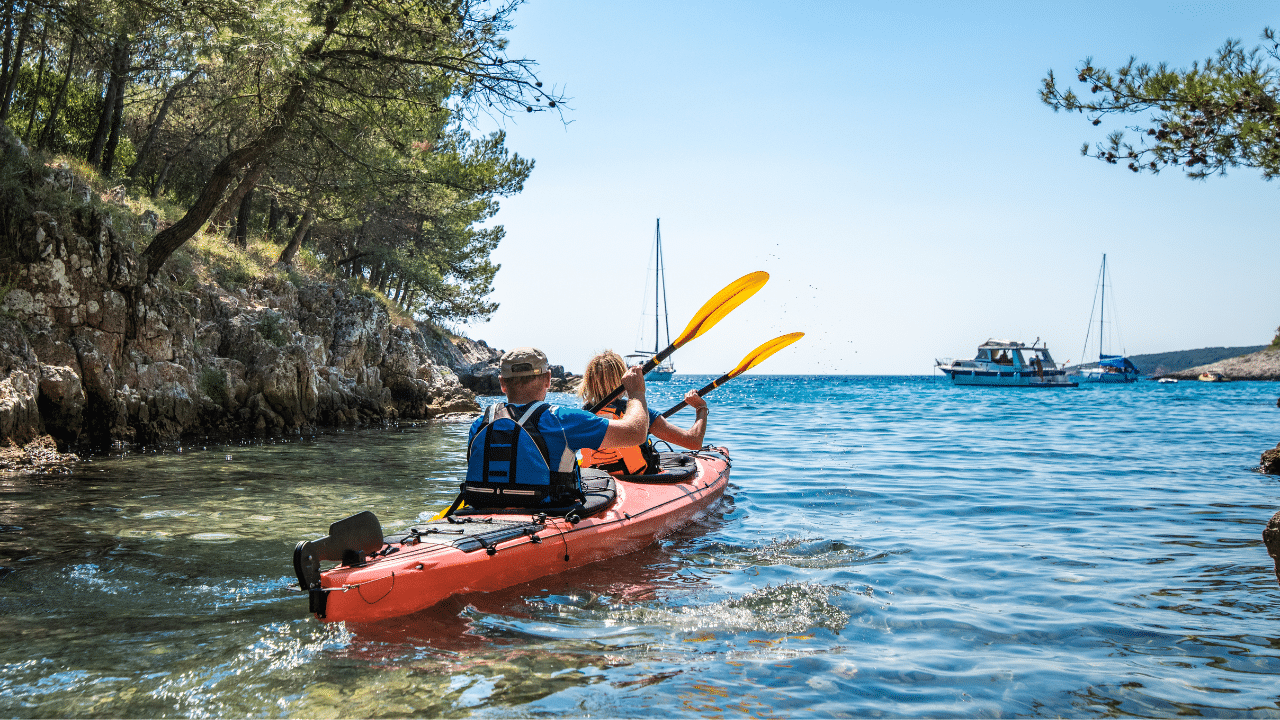How to Paddle a Tandem Kayak: Tips for Harmonious Adventures
Master tandem kayaking with ease! Discover the perks of teaming up on the water and learn to paddle in sync with these simple tips and techniques.

If you’ve spent time near kayaks, you’ve probably heard many jokes about tandem kayaking. I think I’ve either heard them all or told them, but the running gag is that tandem kayaks are a great way to make enemies or ruin relationships.
Humor aside, learning how to paddle a tandem kayak is not hard and can be a fun and rewarding experience.
We’ll offer a few simple suggestions for you and your prospective paddle partner to get you on the water quicker and ensure you want to stay together longer.
Why Tandem Kayaking is Great
First, kayaking is about your personal preference. There’s no right or wrong paddling set-up, and some of my best paddle trips have been from the seat of a solo kayak.
But teaming up can simplify the whole process when paddling with a partner or large group.
The most significant advantage is pace. People kayak at different speeds depending on their body type, strength, experience, and stamina. So the odds of three or more solo kayakers all having the same comfortable pace that’s not too slow and not too fast for anyone is slim.
But what if you went with a pair of doubles instead of four singles?
It’s much easier to keep everyone close, which isn’t just enjoyable, but makes for a much safer kayaking trip if someone needs help. This is especially true if you know that the group ranges from experienced to casual or newcomer.
Tandem kayaks prevent strong paddlers from feeling frustrated and newbies from feeling inexperienced. I suggest matching stronger or experienced paddlers with newcomers. It may lead to an awkward conversation on shore, but it will be much more enjoyable for all once you’re on the water.
Tandem kayaks are, in general, faster than solo kayaks. Longer keels (necessary in tandem kayaks) are faster than shorter designs. And the addition of a second paddler provides more power and efficiency. There’s also something oddly satisfying when you take a moment to catch your breath and realize your tandem kayak is still moving forward.
Paddling in Unison

But you can’t just jump in your tandem kayak and expect to fly across the water. Tandems require communication, patience, and grace to find the appropriate rhythm with your paddle partner. To maximize your speed and paddling efficiency, it’s vital that you and your partner paddle in unison.
This means paddling on the left side together and the right side together. Finding this rhythm can take a few minutes.
Like being in two singles, odds are you won’t have the same pace. You’ll have to adapt and don’t be surprised if your kayak paddles bang together from time to time. Don’t take it personally—even experienced tandem paddlers lose their rhythm occasionally.
Let the Front Paddler Set the Pace
The front paddler is responsible for setting the pace. Since the rear paddler can always see their partner’s pace, it’s much easier for them to match than vice versa.
This doesn’t mean someone riding shotgun can’t take the occasional breather.
I promise the person in the back will keep paddling just fine, and it’s up to the rear paddler to readjust to their partner’s pace once they start paddling again.
Give feedback to your partner. Let them know if the pace is too fast or slow, and try to find a middle ground that both of you are happy with. When in doubt, defer to the slower pace. Kayaking isn’t a sprint; overexerting yourself will lead to sore shoulders and a longer time between destinations in the long run.
They don’t call them the divorce boat for nothing. Always communicate with your partner; if things are going poorly, at least the other person can’t see you roll your eyes.
Put the Stronger Paddler in the Back

This isn’t a hard and fast rule. I’m 6’3, a whole foot taller than my wife, but we’ve had many successful paddles with her in the back and me riding in the front.
But generating more force from the rear position is easier, allowing for a more efficient paddle. And when we’re going for distance or know we have a long day ahead, we’ll usually default to this orientation.
Even for casual trips, putting the stronger person in the back has advantages. It makes it easier for the weaker paddler to set the pace from the front and minimizes the chance of them feeling compelled to keep up with a faster rate than they’re comfortable with.
The Rear Paddler Controls the Steering
Many tandem expedition kayaks have a rudder controlled by foot pedals installed in the rear seat. But even if your tandem kayak doesn’t have a rudder, it’s infinitely easier to control your kayak’s direction from the back.
There’s no reason for the front paddler to change their paddle stroke unless you’re squeezing through a tightly congested area. Instead, the person in the back can add an extra stroke or two on the same side to help correct your course. Specific kayak paddle strokes like the sweep or a wider forward stroke can also help turn your tandem kayak faster.
If you have a rudder, you won’t even have to do that and can maintain your regular paddle stroke and let the rudder do all the turning for you.
